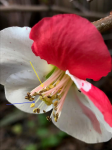bonhe
Masterpiece
One in #187




The reason I keep showing this air-layering is that it is not easy to propagate theToyo nishiki "Nichi-Getsu-Sei" if one really wants to get full characteristics of the specimen. I believe air layering is only way to get the good one for bonsai. This type of quince has a very unique way to produce the flower patterns. If the branch A produces the red flowers, it will be just red flower for the rest of its life. If the branch B produces white flowers, it will only white. If the branch C produces white with red stripe flowers, it will only that pattern; etc.
To create one for bonsai, it takes at least 2 years to get one.
Bonhe




The reason I keep showing this air-layering is that it is not easy to propagate theToyo nishiki "Nichi-Getsu-Sei" if one really wants to get full characteristics of the specimen. I believe air layering is only way to get the good one for bonsai. This type of quince has a very unique way to produce the flower patterns. If the branch A produces the red flowers, it will be just red flower for the rest of its life. If the branch B produces white flowers, it will only white. If the branch C produces white with red stripe flowers, it will only that pattern; etc.
To create one for bonsai, it takes at least 2 years to get one.
Bonhe







































